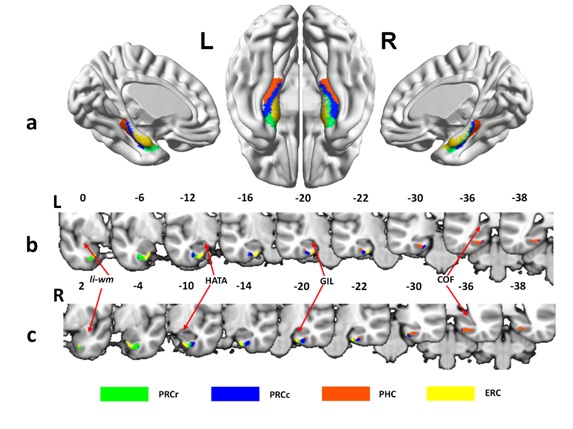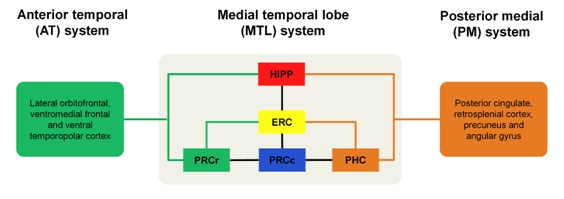The group of Brainnetome Center, Institute of Automation, Chinese Academy of Sciences (http://www.brainnetome.org), for the first time, obtained a well-defined parcellation of the human parahippocampal region (PHR) using connection-based parcellation techniques based on diffusion MRI data. Four major subregions were consistently identified in the PHR in two independent spatial resolution datasets (Fig. 1).
Specifically, a widely-studied area of the lateral PHR, often previously called the parahippocampalgyrus (PHG), which was traditionally separated into the perirhinal cortex (PRC) and parahippocampal cortex (PHC), could be subdivided into the PRCr, PRCc, and PHC. The PRCc is a new sub-region identified in the human PHR atlas.
This parcellation scheme could improve the understanding of the anatomical, connectivity, and functional characteristics of the PHR. Furthermore, the connectivity profiles for each subregion showed that the transition subregion (caudal perirhinal cortex, PRCc) is a functionally integrated subregion that integrates the anterior temporal (AT) - posterior medial (PM) systems (Fig. 2).
In addition, the core components of the AT and PM systems are connected with the PHR in the rostral perirhinal cortex (PRCr) and parahippocampal cortex (PHC), respectively, rather than connecting with the traditional, larger, and thus less concise PRC and PHC areas (Fig. 2).
These results suggest that the lateral PHR not only contain functionally segregated subregions but also contain a functionally integrated subregion.
This study may constitute a major advance in the study of human memory systems and provide the basis for new lines of inquiry about medial temporal lobe function.
This work is one of the major progresses of the Brainnetome Project, which was launched to investigate the hierarchy in the human brain from genetics to neuronal circuits to behaviors, conceptualizing two components (nodes and connections) as the basic research unit.
One of the key elements of this project is focused on setting up and optimizing the framework for connectivity-based parcellation, and aiming to produce a new human brain atlas, i.e. Brainnetome Atlas is based on connectional architecture. The Brainnetome Atlas is an in vivo, and not only with more fine-grained functional brain subregions, but with detailed anatomical and functional connection patterns for each area, which could help researchers to describe the locations of the activation or connectivity in the brainmore accurately.
To facilitate future investigations of the human brain across healthy and pathological states, the Brainnetome Atlas accompanied with the software will be made freely available for download via http://atlas.brainnetome.org, along with the subregional structural and functional connections.

Figure1. PHR parcellation solution (Image by ZHUO et al.)

Figure2. Schematic model summarizing our findings and hypothesis (Image by ZHUO et al.)
Contact:
ZHUO Junjie, FAN Lingzhong, and JIANG Tianzi
E-mail: lzfan@nlpr.ia.ac.cn
Brainnetome Center, Institute of Automation, Chinese Academy of Sciences (http://www.brainnetome.org)
Original Research: Abstract for “Connectivity Profiles Reveal a Transition Subarea in the Parahippocampal Region That Integrates the Anterior Temporal–Posterior Medial Systems” by JunjieZhuo, Lingzhong Fan, Yong Liu, Yuanchao Zhang, Chunshui Yu, and Tianzi Jiang in the Journal of Neuroscience. Published online March 2 2016, doi: 10.1523/JNEUROSCI.1975-15.2016

